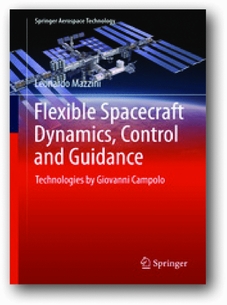
On first opening this book, it is clear that the book is targeted at more advanced students or researchers (Masters or PhD level) with a strong theoretical background. Although the book title is on ‘flexible spacecraft dynamics’, the author tries to cover a range of topics he feels are important to modern satellite Attitude and Orbit Control System (AOCS) design.
Chapters 2 and 3 cover classical kinematics and kinetics of rigid bodies including Lagrangian dynamics and linearised equations of motions and sets up the dynamics framework for the rest of the book. There is information in Chapter 3 on flexible modes: sloshing, solar arrays, antennas – from the title of the book, one would presume that such modes were the focus of this book. Unfortunately, these three items are crammed into less than two pages of a 350-page book and mainly just note the core problems and refer the reader on to more detailed references. Sadly, these areas are the ones most pertinent if you are buying a resource on flexible Guidance, Navigation and Control (GNC) dynamics and are the ones least explained.
Chapter 4 provides an overview of AOCS modes on a satellite including their high-level functional design. The block diagrams showing control architecture are one of the most useful parts of this book, setting the scene behind how real control systems are organised. Chapter 5 is a summary of some optimal control theory including Linear quadratic regulator (LQR), some Linear quadratic Gaussian (LQG), and H-infinity (H∞). Chapter 6 extends this work to include an H∞ design example of a flexible satellite with a large reflector – possibly one of the best case studies in this book. Chapter 7 focuses on setting up classical astrodynamic theory (Kepler's laws, orbital parameters, transfers) and includes finite and infinite thrust scenarios.
Chapters 8 and 9 focus on an overview of spacecraft propulsion systems, and sensors and actuators. The chapters, however, do not approach the technologies from a control perspective, meaning how the technologies integrate into the control loops are not clearly explained.
Overall, there are two core comments on this book: (1) Its attempt to examine many different areas of GNC means that it lacks focus on its core: flexible satellites; areas such as sloshing or rigorous depth into flexible appendages have limited exposure, apart from one good example case in Chapter 6. A disappointment is the introduction that should have been setting up the book on concepts of flexible structures, but instead appears to be a cursory overview of different types of satellite missions. (2) The author mentions in his preface that he provides a ‘practical engineering approach’, which I consider to be lacking. Apart from a couple of end-of-chapter case studies, there are limited examples throughout; the author could produce a better learning experience by cutting back on the theory and expanding the number of examples and how to apply the theory.
In conclusion, this book would be suitable for people with a strong theoretical background which needed to complement their knowledge from other sources. A positive aspect of this book is the variety of provided references at the end of each chapter, giving readers a wide range of sources for further information.


